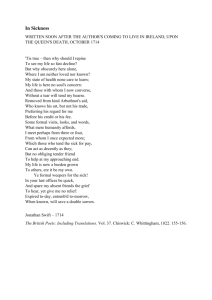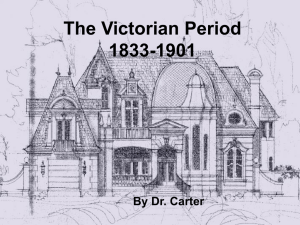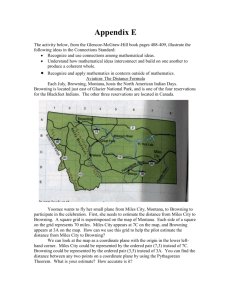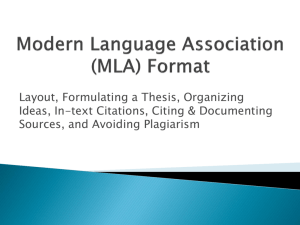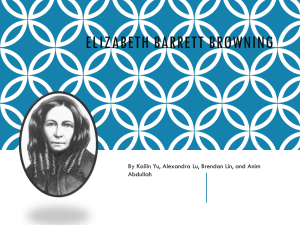Elizabeth Barrett Browning
advertisement
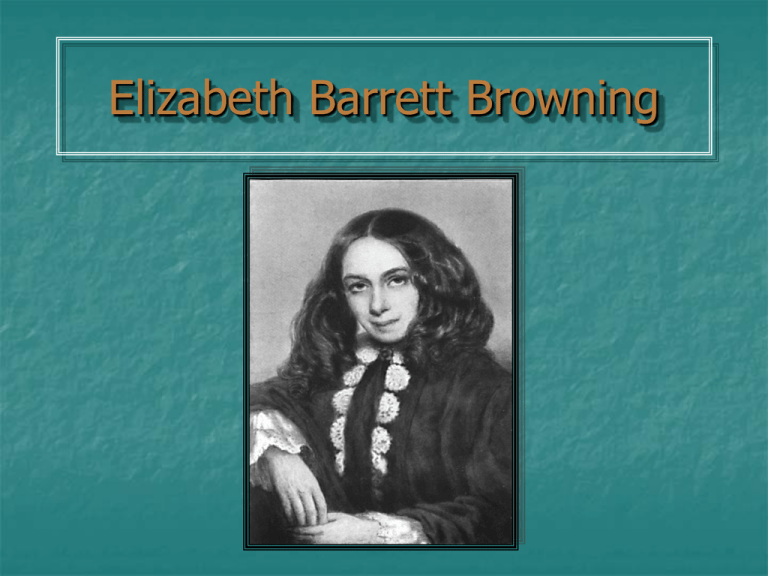
Elizabeth Barrett Browning Elizabeth Barrett Browning 1806 - 1861 • • During her lifetime, Mrs. Browning was considered a better poet than her husband, Robert Browning. Today, her life and personality excite more interest than her work. Widely known for her treatment of social injustice in her poetry: • • Her political and personal sympathies touch on such issues as slave and child labor as well as the repression of women, earning her status as an early feminist. She lived most of her life as a reclusive invalid, yet established and maintained a popularity among critics and the public that made it clear that “no female poet was held in higher esteem among cultured readers in both the United States and England than Elizabeth Barrett Browning during the nineteenth century.” (“Elizabeth Barrett Browning”) Elizabeth Barrett Browning A Brief History . . . • • • • • She was born into a wealthy family (eldest of 12 children). She began writing poetry as early as 8 years old. By the time she was ten, she had read the complete works of Shakespeare, Pope and Milton and had studied the works of prominent classical writers in their original languages. She had also read the entire Old Testament in Hebrew. In 1821, she injured her spine attempting to saddle her horse and began taking opium by prescription (like Coleridge). She became addicted Her mother died in 1828 and not long after, due to financial loss, the Barretts were forced to move to a more modest home, one of three moves until the family finally settled at 50 Wimpole Street in London. In 1837 she developed a chronic cough and coupled with the injury to her spine, she suffered a long period of invalidism. (“Poet’s Corner – Elizabeth Barrett Browning”) Elizabeth Barrett Browning A Brief History . . . • • • • Although a prolific writer, her works drew no critical attention to speak of until the publishing of The Seraphim and Other Poems. This marks the beginning of her successful literary career as critics name her one of England’s most gifted and original poets. (“Poet’s Corner”) She begins corresponding with such prominent literary figures as Wordsworth, Carlyle and Edgar Allan Poe. In 1838, Browning moved to Torquay to improve her health. Here, she was accompanied by family members, most often by her favorite brother (“Bro”). “Bro” drowns in Babbacombe Bay off Torquay in 1840. This deeply impacted Elizabeth and her grief and guilt is the subject of “De Profundis”, published after her death. (“Elizabeth Barrett Browning – A Chronology”) Elizabeth Barrett Browning A Brief History . . . • • • Barrett Browning demonstrates a passion about such issues as slave and child labor and the repression of women. These sentiments are the driving force behind such poems as “The Cry of the Children” (written in 1840) , which is favorably reviewed and very popular. This poem helps to bring about the regulation of child labor. Robert Browning begins writing to Elizabeth in praise of her poetry in 1845. He then visits her and writes a letter declaring his love the following day. Elizabeth begins work on a book of poetry called Sonnets from the Portuguese titled after Robert Browning’s pet name for her, “my little Portuguese.” (“Elizabeth Barrett Browning – A Chronology”) Elizabeth Barrett Browning A Brief History . . . • • • • • Despite her father having strictly forbidden marriage for any of his children, Elizabeth and Robert elope in 1846 in London and then move to Italy where she becomes involved with the cause of political unity. Her father disinherits her. Elizabeth’s health improves greatly and she has a son in 1849 – Robert Weideman Barrett-Browning (“Pen”). In 1850, she is mentioned in a literary journal as the leading candidate to succeed Wordsworth as poet laureate. In 1857, Elizabeth’s father dies and Aurora Leigh is published – “a novel in verse.” It is met with much praise but also draws attacks for “its sympathetic treatment of a woman as independent, an artist, and an unmarried mother.” (“E. B. B. – A Chronology”) Her health declines in 1860 and she dies the following year in Florence where she is buried. (“Elizabeth Barrett Browning – A Chronology”) Elizabeth Barrett Browning A Brief History . . . • • “De Profundis” is published posthumously in Last Poems in 1862. Emily Dickinson and Virginia Woolf credit Elizabeth Barrett Browning with giving a voice to female poets. Dickinson says that her work is deeply affected and informed by Barrett Browning’s sensibilities. (Everett & Isaacs). “One thing is certain, however, her immortality is assured – she stands already crowned. As long as one human heart throbs for another she will be held in high esteem.” (Smith). What’s LOVE got to do with it?? With a partner consider these questions and jot down some answers for discussion: 1. 2. 3. 4. We all know that people fall in love and out of love, but how does it work while you're in it? What kinds of love are there, and how and when do they happen? What if you love someone in many different, conflicting ways? Talk about some examples with your partner. These are eternal human questions, and they're the questions Barrett Browning asks – and tries to answer – in her sonnet – “How do I Love Thee? Let me Count the Ways.” “How do I Love Thee? Let me Count the Ways” Sonnet XLIII from Sonnets from the Portuguese 1. 2. 3. 4. 5. Read “How do I Love Thee?” and write a three-sentence summary of the sentiment it conveys. How would the poem be different if the opening line was "Why do I love thee?" How many ways of loving does the speaker identify? Do these ways of loving overlap, conflict, or complement one another? Explain. Why do you think "How do I love thee?" is such a popular love poem? What features of the sonnet might make it more accessible or universal than other love poetry? How would the poem affect readers differently if the beloved was referred to as "you" instead of as "thee"? What if the beloved was given a first name – Romeo, Robert, etc.? Sonnet 43 6 . 7. 8. a) Make a list of at least four poetic devices Barrett Browning employs in this poem. b) For each, provide a brief explanation of what the device contributes to the poem as a whole. It could, for example, inform the poem’s structure, theme, or imagery. Identify three features of this poem that give it a place in the Victorian age. Explain your ideas. What theme is communicated in this poem? In what tone is this theme conveyed? Support your answers with evidence from the text. Sonnet 43: Consider This . . . • • • • E. B. Browning is probably best known for this sincere and unabashed delineation of her love for Robert Browning, for whom the entire book of poetry was penned. In this poem, Browning uses imagery that portrays love as ethereal, a spiritual experience. Conversely, she describes her subject (love) as three dimensional, making her experience of love concrete, rather than abstract. In her marriage of the concrete and abstract in this poem, Browning effectively conveys love as something that transcends tangible experience (a decidedly Romantic expression of sentiment) but that can also be “known” (certainly palatable for the Victorian leaning toward rationalism). In this, she demonstrates a blending of Romantic and Victorian sensibilities, placing herself on the cusp of the two eras. How Do I Love Thee? This is a wonderfully written poem describing with great passion her love for her significant other. 01. How do I love thee? Let me count the ways. The number of ways she loves are numerous. She would need to count them. 02 I love thee to the depth and breath and height Her love is three dimensional and therefore real, in the sense that all real physical things in the universe are three dimensional. Breadth is width, a measurement of how far across her love is. Height and depth represent how far down (deep) and how far up (high) her love is, in relation to her position in the universe. 03. My soul can reach, when feeling out of sight These measurements, though physical are also spiritual, as they pertain to her soul, which is body and spirit infused. 04. For the ends of Being and ideal Grace. This physical and spiritual measurement is of her soul and the very essence of her being to the ends of her existence.. Ideal Grace is capitalized and probably refers to God, and His most perfect gift–Salvation, and the opportunity to experience eternal love and bliss in His presence. She likens her love for her husband to that love of God. 05. I love thee to the level of every day’s 06. Most quiet need, by sun and candlelight. Her love is on the same level as our most basic needs–air, water, food, shelter, kinship and love–that need our attention day and night. 07. I love thee freely, as men strive for Right; She loves him of her own free will, and not out of obligation. This is the kind of love that is freely given without any coercion by guilt or force or the threat of force. Men strive for Right freely, for it is necessary to their happiness. 08. I love thee purely, as they turn from Praise. Modesty turns from praise because it needs it not. She loves him for the sake of love itself, and not to receive any praise. 09. I love with a passion put to use 10. In my old griefs, and with my childhood’s faith. Passion put to use in her old griefs, is passion that hurts, that reminds one through pain that she is still alive. The same passion exists in the faith of a child, who believes without doubt because of a lack of life experience that would go contrary to it. 11. I love thee with a love I seemed to lose 12. With my lost saints, She loves him with the intensity one feels love during their innocence of youth, which she lost with her innocence, and feels it again for him. 13. I love thee with the breath, Smiles, tears, of all my life! She loves him with the breath of her life, with the happiness and sadness of her life. – and, if God choose, 14. I shall but love thee better after death. Her love for him will not end at the grave, but, God willing, will continue on eternally “A Man’s Requirements” 1. Read “A Man’s Requirements” and, with a partner, chart the similarities and differences between this and the previous poem, “How do I Love Thee?” Similarities Differences Do YOU see the Difference?? 2. 4. 5. Now, take another look at your chart and be specific about these comparisons and contrasts between the two poems. To do so, consider the following elements: Tone Speaker Imagery Structure Theme Other?? Which poem sends a stronger message? Defend your answer. E. B. Browning was criticized for writing against the ”subjugation of women to the dominating male” (Everett & Isaacs) in an era that held unwavering views of the role of women in society. With reference to this social climate and to the poem, demonstrate how “A Man’s Requirements” is a reaction to Victorian sensibilities. Works Cited • • • • • “Elizabeth Barrett Browning.” The Columbia Encyclopedia, Sixth Edition. 2008. 21 Jul 2009. http://www.encyclopedia.com/topic/Elizabeth_Barrett_Browning “Elizabeth Barrett Browning – A Chronology.” The Victorian Web. 21 Jul 2009. http://www.victorianweb.org/authors/ebb/ebtl.html Everett, Glenn and Isaacs, Jason. “The Life of Elizabeth Barrett Browning.” The Victorian Web. 2002. 22 Jul 2009. http://www.victorianweb.org/authors/ebb/ebbio.html “Poet’s Corner – Elizabeth Barrett Browning” 22 Jul 2009 http://www.gale.cengage.com/free_resources/poets/bio/browning Smith, George Barnett. “Elizabeth Barrett Browning.” The Victorian Web. 2005. 22 Jul 2009. http://www.victorianweb.org/authors/ebb/cornhill.html
